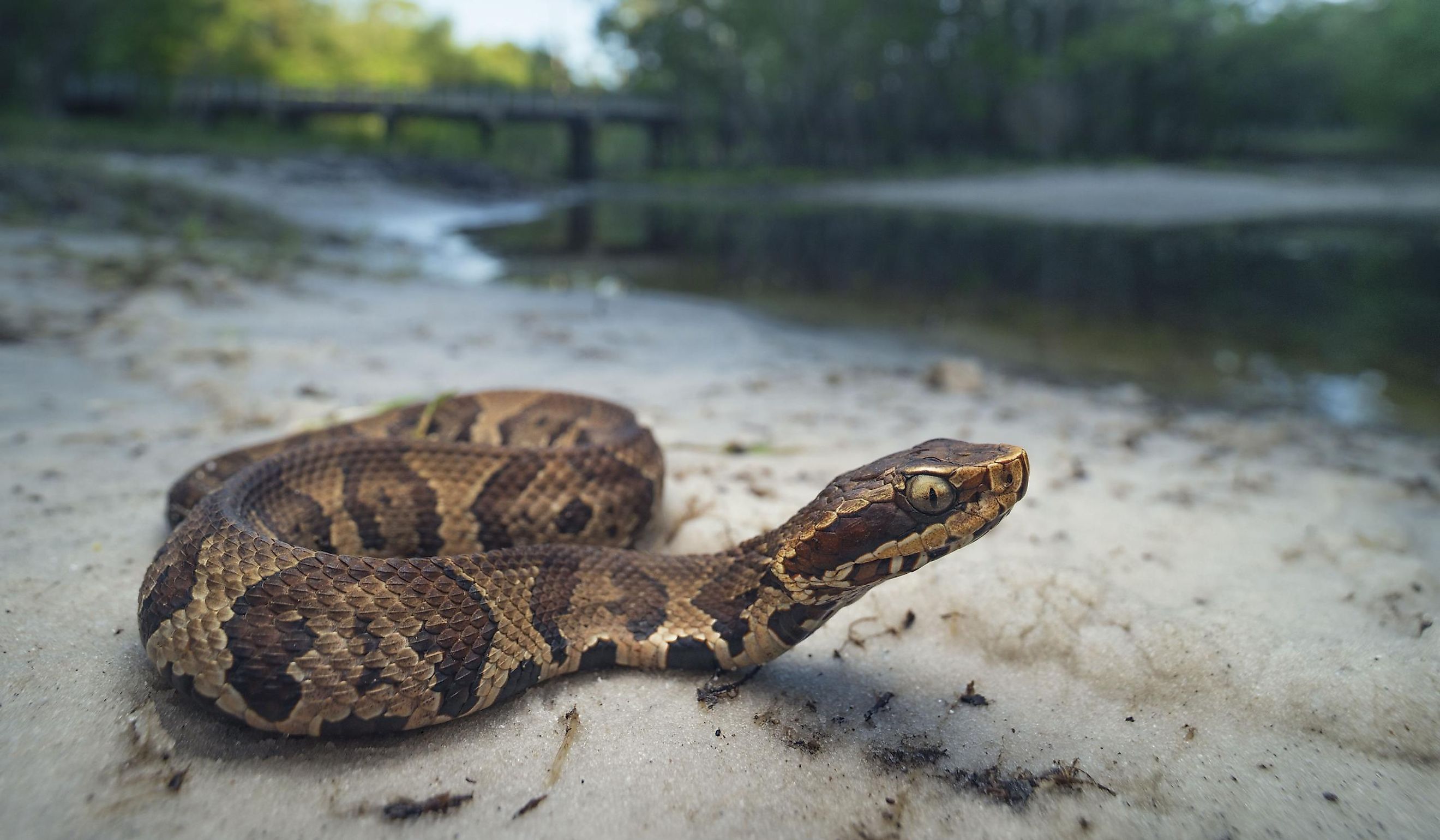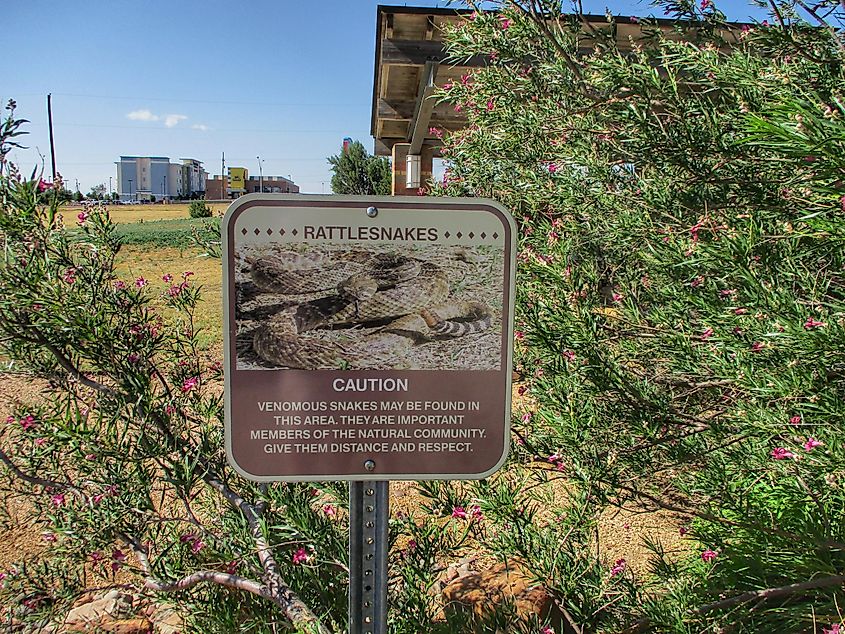
Which State Has More Venomous Snakes: Texas or Florida?
Think of Texas, and you may visualize a tumbleweed rolling across a long desert road while the quintessential rattlesnake sound accompanies the scene. Think of Florida, and you may shudder at what slithers within the undeveloped swamps and coastal marshlands. For both southern states, snakes are a common occurrence. And where there are healthy populations of snakes, there tend to be at least a few dangerous varieties. A bite of any kind is never fun, and large constrictors pose an entirely different kind of problem, but the aim of this article is to determine which state has more venomous snakes: Texas or Florida?
Venomous Snakes of Texas

105 species and subspecies of snakes call The Lone Star State home. Of those, 15 are venomous. These potentially harmful serpents fall into four categories: copperheads, cottonmouths, rattlesnakes, and coral snakes. The first three belong to the pit viper subfamily, while the latter belongs to the Elapidae family, of which the cobras of Asia and Africa are also members. Let's look a little closer (but not too close!) at the various venomous snakes in Texas.
Copperheads

There are three species of copperheads in Texas, each carving out their own territory. The Southern copperhead (Agkistrodon contortrix) lurks in the eastern third of the state, the Broadbanded copperhead (A.c. laticinctus) covers the central and western chunks, and the Trans-Pecos copperhead (A.c. pictigaster) is isolated in the southern part of the Trans-Pecos (i.e. west of the Pecos River – an area dubbed "Far West Texas"). While the three subspecies vary slightly in appearance, they are generally 1.5 to 2.5 feet in length and have reddish-brown or chestnut-colored crossbands spanning their pale or very light-brown bodies.
The Cottonmouth

The sole subspecies of cottonmouth found in Texas is the Western cottonmouth (Agkistrodon piscivorous). This hefty snake averages about 3.5 feet in length and can range in color from olive green, olive brown, dark brown, and even approaches solid black. Individuals also exude varying degrees of wide and dark crossbands. But regardless of the external appearance, all cottonmouths have the characteristic white tissue inside their mouths (from which the species gets its name) – only shown when in a defensive posture or in the midst of a strike. Contrary to its name, the Western Cottonmouth is actually found in the eastern half of Texas. Given that it is a semi-aquatic snake (referred to as a water moccasin in some circles), this venomous species keeps close to slow-moving bodies of water, such as streams, ponds, swamps, and coastal marshes.
Rattlesnakes

Texas lays claim to many types of rattlesnakes, but which can be categorized into two genera. Of the Sistrurus genus, there is the Western massasauga (S. catenatus) and the Desert massasauga (S.c. edwardsii). And of the Crotalus genus, there is the Western diamondback (C. atrox), Timber rattlesnake (C. horridus), Mottled Rock rattlensnake (C. lepidus), Banded Rock rattlesnake (C.k. klauberi), Blacktail rattlesnake (C. molossus), Mojave rattlesnake (C. scutulatus), and the Prairie rattlesnake (C. viridis viridis). Each variety looks a little different (or sometimes, a lot different), but they all possess the distinctive sound from which the species takes its name. When threatened, rattlesnakes vibrate their tails at a high rate of speed, causing the scales to strike each other and produce less of a rattle and more of a buzzing sound.
The Coral Snake

The Texas coral snake (Micrurus fulvius tener) is the only North American cobra (i.e., a member of the Elapidae family) to slither into the Lone Star State. Like other stateside coral snakes, it has bright red and black bands separated by thinner yellow bands. The Texas coral snake is a slim species, and grows upwards of 2.5 feet in length. If you are hiking in the woodlands, canyons, or coastal plains of southeastern Texas, then remember the rhyme: "Red on yellow, you're a dead fellow. Red on black, you're OK, Jack." This safety prompt is helpful for stateside coral snakes (though still imperfect), as other non-venomous snakes have evolved similar vibrant bands to fool would-be predators.
Venomous Snakes of Florida

Estimates on the number of snake species and subspecies native to Florida generally range between 44 to 46 (however, given the invasive python problem and the emergence of anacondas in the Everglades, the overall figure is closer to 50), but sources agree that there are six venomous types. Like Texas, The Sunshine State covers the categories of copperhead, cottonmouth, rattlesnake, and coral, but with some subspecies variations (and a bit of overlap too). Let's get into the weeds (and swamps, scrublands, forests, mangroves, etc.)!
The Southern/Eastern Copperhead

Florida has the same singular subspecies of copperhead that Texas does. Here, the Southern copperhead (Agkistrodon contortrix) is often referred to as the Eastern copperhead and sometimes as the Highland moccasin. The coloration is consistent with its Texan compatriot, though it tends to grow a few inches longer (i.e., up to 3 feet) in Florida. This heavy-bodied pit viper is found only in the deciduous forests, swamp edges, wetlands, and rocky hillsides of the Panhandle (i.e., Northwest), where it loves to feast on cicadas and other insects, as well as rats (great reasons to protect this non-confrontational and only mildly venomous snake), birds, amphibians, and other snakes.
Cottonmouths

There is one primary cottonmouth snake that is inhabiting Florida. The Florida cottonmouth (Agkistrodon conanti) exists in every single county, in nearly all freshwater environments. Cottonmouths do have a reputation for being aggressive, but most of the time, they prefer to flee dangerous situations and instead concentrate their venomous strikes on fish. The Latin name of the latter (piscivorous) means "fish eater" – a habit that pertains to both Floridian subspecies and cottonmouths as a whole. This species is often referred to as a water moccasin due to its semi-aquatic ways.
Rattlesnakes

Three types of rattlesnakes (all venomous) can be seen basking throughout The Sunshine State. The Eastern diamondback rattlesnake (Crotalus adamanteus), the heaviest pit viper on the continent, can be found statewide in dry places such as pine woods and even golf courses. The Timber rattlesnake (C. horridus), aka the Canebrake rattlesnake, has one of the largest ranges of any snake in North America, though locally, it only resides in small parts of the north. And the Dusky Pygmy rattlesnake (Sistrurus miliarius barbouri) also covers the entirety of the state (save for the Florida Keys), and other portions of the American southeast. Look for this small rattler (roughly 15-21 inches) in natural wooded areas (where they can wait in ambush), but also, on occasion, in suburban neighborhoods.
Coral Snake

The type of coral snake that roams the whole of Florida (as well as several states up the East Coast and several more westward into the northeastern Gulf Coast) is the Eastern coral snake (Micrurus fulvius), which, because of its ostentatious colors (i.e., black, yellow, and red), is also known as the Harlequin coral snake. It is easy to confuse this venomous species with the non-venomous scarlet snake, or especially the similarly-banded, non-venomous scarlet kingsnake, but just remember the aforementioned rhyme and look for the black, blunt head, and you'll be able to correctly identify which is the bearer of a potent neurotoxin. Despite its standout colors, the Eastern coral snake likes to hide away in long grass or under fallen leaves.
The Verdict
Texas has over twice the amount of venomous snakes as Florida (15 vs. 6) and over double the amount of native snake species/subspecies (105 compared to around 45). I'm not sure if this makes Texas the "winner" or not, as that will depend on one's subjective evaluation of snakes. But regardless of personal feelings, there is no doubt that snakes serve an important role in the food chain and overall health of the ecosystem. They help manage rodent populations, for instance, and they are themselves a source of food for many other predators.
In terms of potential risks, there are only about five deaths per year in the United States that are attributed to bites from venomous snakes. This is because theoretically harmful serpents only strike when provoked (so simply leave them be) or when stepped on (so wear protective footwear if traversing untrodden brush) and because most Americans can get access to efficacious antivenoms within a reasonable timeframe. So fear not, residents of Texas and/or Florida, or vacationers to either southern state, venomous snakes are unlikely to be a problem.











